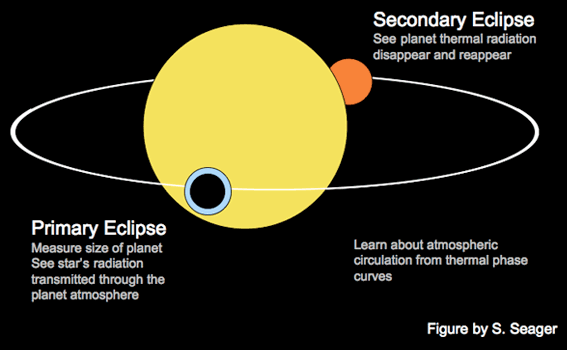Exoplanet Atmospheres
The goal in studying exoplanet atmospheres  is to understand the atmospheric composition and temperature. We want to be able to recognize planet atmospheres like Earth’s: with water vapor, oxygen, ozone, and carbon dioxide. These strong absorbers would make the major contributions to the spectrum we could observe from afar. While the detection of true Earth twins is some time off, we are busy trying to understand hot Jupiter and hot Neptune atmospheres observed by primary and secondary eclipses for transiting exoplanets. Professor Seager’s group’s research focuses on computer models of exoplanet atmospheres and interpretation of data from space telescopes.
is to understand the atmospheric composition and temperature. We want to be able to recognize planet atmospheres like Earth’s: with water vapor, oxygen, ozone, and carbon dioxide. These strong absorbers would make the major contributions to the spectrum we could observe from afar. While the detection of true Earth twins is some time off, we are busy trying to understand hot Jupiter and hot Neptune atmospheres observed by primary and secondary eclipses for transiting exoplanets. Professor Seager’s group’s research focuses on computer models of exoplanet atmospheres and interpretation of data from space telescopes.
First Generation Exoplanet Atmospheres Highlights:
- The first paper on hot Jupiter atmospheres:
Seager, S., & Sasselov, D. D. 1998, “Extrasolar Giant Planets Under Strong Stellar Irradiation”, ApJ, 502, L157-161. - The first description of exoplanet transmission spectra, that led to the first detection of an exoplanet atmosphere:
Seager, S., & Sasselov, D. D. 2000, “Theoretical Transmission Spectra During an Extrasolar Giant Planet Transit”, ApJ, 537, 916-921. - Co-authored one of the first two independent detections of photons from an exoplanet atmosphere:
Deming, D., Seager, S., Richardson, L. J., & Harrington, J. 2005, “Detection of Infrared Radiation from an Extrasolar Planet”, Nature, 434, 740-743. - First general description of super Earth atmospheres, lead by Prof. Seager’s student Eliza Miller-Ricci:
Miller-Ricci, E., Seager, S., & Sasselov, D. 2009 “The Atmospheric Signatures of Super-Earths: How to Distinguish Between Hydrogen-Rich and Hydrogen-Poor Atmospheres”, ApJ, 690, 1056-1067.
Second Generation Exoplanet Atmospheres Highlights:
- The first paper on exoplanet atmosphere retrieval (led by then PhD student N. Madhusudhan):
Madhusudhan, N. & Seager, S. 2010, “A Temperature and Abundance Retrieval Method for Exoplanet Atmospheres”, ApJ, 707, 24-39. - One of the modern cornerstones of modern exoplanet atmospheric retrieval (led by then PhD student Bjoern Benneke):
Benneke, B., & Seager, S. 2012, “Atmospheric Retrieval for Super-Earths: Uniquely Constraining the Atmospheric Composition with Transmission Spectroscopy”, ApJ, 753, 100-121. - A new planet mass estimation technique (led by then PhD student Julien de Wit):
de Wit, J. & Seager, S. 2012, “Constraining Exoplanet Mass from Transmission Spectroscopy”, Science, 342, 1473-1477. - A photochemistry code constructed from scratch for exoplanets, with several applications under either reduced or oxidized conditions. We hope to make it available in python in the future (led by then PhD student Renyu Hu):
Hu, R., Seager, S., & Bains, W. 2012 “Photochemistry in Terrestrial Exoplanet Atmospheres. I. Photochemistry Model and Benchmark Cases”, ApJ, 761, 166-195.
